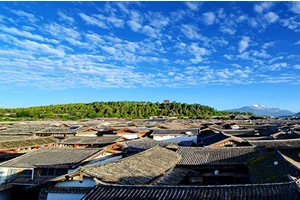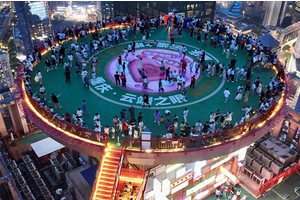Dongfang travel agency
Dongfang Wenlv and Dongfang Selection are both brands of New Oriental Education Technology Group.
Dongfang Wenlv and Dongfang Selection each focus on different business fields, but both are committed to providing users with quality services and products. Oriental cultural tourism is the layout of New Oriental in the field of cultural tourism industry, aiming at providing users with rich cultural tourism products and services.
Relying on the rich educational resources of New Oriental, Dongfang Wenlv provides users with a unique cultural tourism experience with the mode of knowledge+tourism. Through online platforms and offline stores, Dongfang Wenlv provides consumers with all kinds of cultural tourism products, including scenic spot tickets, hotel packages and group tours.
Oriental Selection is the exploration of New Oriental in the field of live e-commerce, focusing on providing users with high-quality educational products and educational resources through live delivery. The anchor team selected by Dongfang is composed of former teachers of New Oriental Online, who bring interesting and informative live content to the audience with their rich teaching experience and professional knowledge.
In the live broadcast room selected by the East, the anchors not only introduce products, but also share educational experience, subject knowledge and learning methods, so that consumers can learn knowledge while shopping.
The characteristics of Oriental Cultural Travel:
1. In-depth integration of culture and tourism: The characteristic of Oriental cultural tourism lies in deep excavation and utilization of local cultural resources, closely combining rich historical culture, folk customs and tourism experience. By creating cultural tourism projects and activities with local characteristics, such as theme parks, cultural blocks, and non-legacy exhibitions, visitors can deeply understand and feel the charm of Chinese culture during their play.
2. Innovative technology application enhances experience: Dongfang Wenlv pays attention to the application of technological innovation in tourism, and adopts advanced technologies such as virtual reality, augmented reality and Internet of Things to provide visitors with an immersive and interactive travel experience. The application of these innovative technologies not only enhances the attractiveness of tourism products, but also promotes the digital transformation of tourism.
3. Green environmental protection and sustainable development: Dongfang Wenlv adheres to the concept of green environmental protection in project planning and operation, and is committed to protecting the natural environment and cultural heritage and realizing the harmonious symbiosis between tourism and ecological environment. The company advocates low-carbon tourism, implements energy conservation and emission reduction measures, and pays attention to community participation and benefit sharing to promote the sustainable development of local economy and society.
Reference to the above content: Baidu Encyclopedia-New Oriental Wenlv Group
Fulongyuan site is located on Fulongyuan in the north of Rongcun, Sigeng Town. The site covers an area of 280,000 square meters, which was discovered in 1986. Now most of it has been turned into a cultivated dry garden, and most of the cultural accumulation on the topsoil has been destroyed. From the analysis of several natural sections of the site, the cultural layer is 1-2 meters thick, and shells, sand-mixed pottery pieces, geometric printed pottery pieces and animal bones are found on the upper layer of the two-layer pile.
Geometrically printed pottery is mostly grayish brown, which is made in wheels. The decorative patterns are scratched, checkered and rippled, etc. The main types of pottery are pots and urns, which are the cultural layer of the Han Dynasty. Shells, sand pottery pieces, ground stone tools and animal bones were found in the lower layer. Almost all the pottery with sand is plain, mainly brown pottery, with a small amount of polished black pottery. Pottery is hand-made, with pots as the main types, and foot-circling devices and bridge-shaped ears are popular;
Stone tools include trapezoidal stone axe and stone spear. Most of the limb bones of cloven-hoofed animals found have traces of cutting and scraping, and there are a few bone implements and cattle teeth, which are Neolithic remains. Fulongyuan site is the largest Neolithic site discovered in Hainan Province. Now it is a provincial-level cultural relics protection unit;
In addition to the Fulongyuan site, the early Neolithic sites in the East and the Beiqiu New Street in the East are the more important cultural relics. The site is located only 2.5 kilometers from the mouth of Beili River in Dongfang City. The site is widely distributed, about 16,000 square meters. The cultural layer 0.4-1.0 meters away from the surface contains a large number of snail shells, shells, burnt earth, carbon chips, burnt bones, and relics such as stoneware and pottery pieces. Stone tools are still made by striking method, and it is rare to grind stone tools;
The Xinjie site is near the river and the sea, and snails, mussels and oysters on the sea have become the main food sources of the ancients, so a large number of shell remains have been found in the accumulation of cultural layers, which is called shell mound;
The pottery in shell mound, Xinjie is coarse pottery with sand, mainly gray-brown pottery, with a general temperature, crisp and loose pottery and uneven wall thickness. There are very few shapes, only round-bottomed tanks and round-bottomed kettles. Generally, it is plain, with a small amount of decoration with thick rope patterns. These thick rope patterns have practical value such as reinforcement, or are used to beautify pottery, expressing the original aesthetic consciousness of ancestors;
Feudal social era;
Oriental E'xian Ridge-the birthplace of March 3;
E'xian Ridge is located in Guangba Township, Dongfang City, on the northeast bank of the middle reaches of Changhua River, 60 kilometers away from Basuo Town, the county seat. The grand event on March 3rd originated in E'xian Ridge, the eastern city, with a well-known local legend. According to legend, a long time ago, this cave was a crow's nest. Crows devour poultry, humiliate crops, and rob beautiful girls everywhere, which makes the people around Li people panic and unable to live and work in peace and contentment;
One day, a beautiful Li girl, Erniang, went up the mountain to pick wild flowers and was caught in a hole by a crow. My mother's sweetheart, Aki, was heartbroken. On March 3 this year, Gui went up the mountain with a sharp knife and bow to save his mother. Fighting with the crow spirit on the mountain, he was killed by the crow spirit because of his skill defeat. The Russian mother was very sad when she heard the news and vowed to kill the crow essence. She kept a straight face and carefully looked for opportunities. One day, the crow spirit came back very tired and slept like thunder;
Russian Niang quietly walked beside the crow essence, pulled out the awl on her hair and quickly pierced the crow essence's eyes. The crow was blind and ran about in the cave. Russian mother took the opportunity to shoot three arrows into the heart of crow spirit with the bow and arrow brought by Pell, revenged Pell, and did great harm to the common people.
Since then, my mother will never marry, but she can sing the love songs that she sang when she was in love with Agui in Exian Cave on the third day of the third lunar month every year. Later, the Li people named this cave the "Oniang Cave" in memory of Oniang. This mountain is also named Jiufeng Mountain, the mother of Russia. On March 3rd every year, unmarried young men and women of Li nationality gather in E'xian Ridge with heavy makeup and sing love songs to find their Mr Right. This move has expanded year by year and generally spread to the residential area of Lipong in Hainan, becoming a grand traditional festival of Lipong in Hainan;
Exian Cave, formerly known as Erniang Cave, is located halfway up the mountain in the northeast of the main peak, which is bottomless and winding. There are three stone halls, which can accommodate tens of thousands of people. Scraggy, the cave wall, has its own shape and various forms, which is interesting. Below the stone hall, there is running water spinning, the waves break the caves and cliffs, the sound is magnificent, the water is _ _, the spirit is cold and the bones are cold, and it is quiet. Where this flowing water comes from and where it belongs has been unknown for thousands of years;
E'xian Ridge was designated as a tourist scenic spot by Hainan Provincial People's Government in 1988.
Tiannan first spring (Hanma Fubo well) day;
The South First Spring is an ancient well in Han Dynasty, named "Hanma Fubo Well". The wellhead is quite large, with an 8.2-foot square well made of Chinese brick and bluestone. Later, the villagers changed this Gu Quan well in Han Dynasty into a round well, which has a long history of nearly 2,000 years.
The well is located in Shisuo Village, Basuo Town, which has a history of nearly 2,000 years. The name of the village dates back to the 19th year of Liu Xiujianwu, Guangwu Emperor of the Eastern Han Dynasty (AD 43). After Fubo's general Ma Yuan unified his troops to settle his toes in the south, he crossed the sea and entered Qiong to guard the tenth station of the southern Xinjiang army. Garrison near the sea, military forces suffer from no well to draw water;
Ma Yuan organized soldiers to dig out the spring water at the "Feilai Temple" next to the village. The water quality is sweet and never exhausted, and it has the reputation of "Thanksgiving is the first sweet spring". Up to now, ten villagers are still used to drinking water around the well in the morning, and the well monument of Hanma Fubo, which was built in the 26th year of Qianlong in Qing Dynasty (AD 1761), is still embedded beside the well.
"Hanma Fubo Well" is listed as a key protected cultural relic by Dongfang Municipal People's Government.
Jiulong County Governance Site is located at the seaside on the west side of gancheng town School Village. There used to be a Jiulong Mountain here. It is said that there are nine dragons hidden under the mountain, so the county seat was named after it was built in Jiulong Mountain.
According to the Records of Qiongzhou Prefecture, "Jiulong County was built in Jiulong Mountain in the first year of Han Yuan Feng (the first 110 years)". In the third year of Emperor Yangdi's great cause (607), Thanksgiving County was established, but the county administration was still in the former site of Jiulong County. During the Ming Dynasty (1436-1449), the county site was moved to Zhonghe Township (now Gancheng);
The site of Jiulong County has a history of more than 2,000 years. Today, there are still broken walls, broken bricks and broken tiles of the city. The Kowloon Beacon Tower next to the county was built in the Ming Dynasty, and there is still a platform with a height of more than one meter. The site proves that the East is one of the early development areas in Qiongzhou.
Thanksgiving county governance site;
Gancheng town Gancheng Village. In the third year of the Great Cause of Sui Dynasty (607), the court set up Thanksgiving County in the former site of Jiulong County in Han Dynasty (now the entrance village of gancheng town is to the west, and the Beibu Gulf is to the west), and the county was located in Jiulong Mountain. During the Ming Dynasty (1436-1449), in order to meet the needs of economic development and military defense, the county moved south to Zhonghe Township (now Gancheng Village) and built a earthen city;
According to "Records of Qiongzhou Prefecture", "The city is 394 feet around, 1 foot wide, 2 feet high, 750 pheasants, 2 bunks and 3 gates." After years of disrepair, he fell into ruin. Restoration in the 43rd year of Emperor Kangxi of Qing Dynasty (1704). As the oldest county in the history of the East, Ganen County has experienced more than 500 years. I am grateful that there were Xuegong (Confucius Temple), Chenghuang Temple, Guanyue Temple and government offices in the city at that time. Today, only the base of the wall is left, and the moat is only 6-8 meters wide in the southwest outside the city. Only the Xuegong (Confucian Temple) and Guanyue Temple are left in the city, and the rest of the buildings are gone. It is a municipal cultural relics protection unit;
Thanksgiving Academy, also known as Confucian Temple. Located in Gancheng Village, gancheng town. Founded in the Song Dynasty, the original site is in the present gancheng town School Village. Ming Hongwu was rebuilt in 1370. Moved to this site during the Ming Dynasty;
During the 10th-25th year of Wanli in Ming Dynasty (1582-1597), he moved to Daya Slope (now Shengwang Village in gancheng town) with the county government. In the twenty-fifth year of Wanli (1597), the county government moved back to this site and rebuilt it. It consists of Dacheng Hall, Chongsheng Temple, Minglun Hall and Lingxingmen. In the 20th year of Jiaqing in Qing Dynasty (1815), Dacheng Hall and Chongsheng Temple were rebuilt when the magistrate was waiting for the DPRK.
Today, only the rebuilt Dacheng Hall is preserved. Minglun Hall and Chongshen Temple have been rebuilt for other purposes except the foundation, and the rest of the buildings are gone. Dacheng Hall is rectangular in plane, supported by 16 columns, with a width of five rooms, 18.5 meters and a depth of 10.5 meters. It rests on the top of the mountain with double eaves. Statues, sacrificial vessels and inscriptions in the temple are all gone. Dacheng Hall is now used by gancheng town Grain. It is a municipal cultural relics protection unit;
Ancient Town Zhoucheng Site;
Located in the northeast of Zhongfang Village, Dongfang Town. According to the compilation of manuscripts of Song Dynasty, in the first year of Huizong Daguan in the Northern Song Dynasty (1107), Wang Zudao was sentenced to cross the sea to observe the wind, saying that Lebanon was vast and its counties were sparse, and he was invited to establish a town and state in the land where Li was born to strengthen his rule. It has jurisdiction over Tonghua and Sida counties, guarding the traffic arteries from ancient Qiongxi to the hinterland of Wuzhishan;
Four years later, in the first year of Zhenghe (1111), it was abolished because there were not many goods on business trips in the town and state, and there was no one traveling between them. Guzhen Prefecture is a stone city, square, with 200 meters on each side and an area of about 40,000 square meters. Today, I saw Tucheng, which divided the east, south and north. The maximum length of the wall is 3.5m, and the top width is 1m.
There is a moat 6-8 meters outside the city wall, and the deepest part in the northwest corner is still 3 meters. Outside the East Gate, there is a cemetery next to the moat, and there is a brick kiln site in the southeast outside the city. Brick fragments are scattered on the site, and some tiles have stamp marks or words. Unearthed Song Dynasty pottery urn, etc. It is a municipal cultural relics protection unit;
Fuque's hometown is located in the west corner of Juhou Village, Sanjia Town, Dongfang City. There are four tombs, respectively, for the Northern Song Dynasty scholar Fu Que, his father Fu Anhui, his uncle Fu Anfu and his grandfather Fu Xingchen. Fu Que, originally from Wenchang (his father moved to Changhua), was the seventh ancestor of Du Qiong;
According to Changhua County Records, Fu's ancestor was from Wanqiu, Henan Province, and his surname was Lu. He used to be the "Fu Xiling" who was in charge of the imperial seal of the State of Qin, and was given the surname "Fu". Fu Youchen, the ancestor of Guo Qiong, was ordered to cross Qiong and caress Li Yougong in the second year of Emperor Li Yelong's record in the Tang Dynasty (AD 889), and Jia Feng became the hereditary "Wan Huhou" and settled in Danshui Village, Changsha Town, Wenchang. Fu is indeed the sixth generation grandson, and has moved to Sandu Town and Changhua Town of Danzhou with his father.
Fu Zhen, Changhua people. Influenced by Su Dongpo's spread of Central Plains culture, teenagers are quiet and eager to learn, and have a wide knowledge of classics and history. In the second year of Zhao Ji Daguan, Emperor Weizong of Song Dynasty (AD 1108), Fuque won the first place in the rural examination and became the "Xieyuan" of the town and state. The following year, he went to Beijing for the palace examination scientific research "unprecedented" and was the first scholar in Hainan history;
In his later years, he returned to his hometown to promote education, built a "Great Holy Hall" and a "Xingxianfang" for giving lectures and running education, and purchased Yantian to encourage later school students to raise tuition fees;
Yushan Cliff Stone Carving is located in Yushan reach of Dongfang River at the junction of Zhongfang Village in Dongfang Town and Chen Long Village in Tianan Township (called Shishu River by local people). There are three stone carvings carved on the rocks on the east bank of the river. One is the stone carving of "Da Yuan Jun Ma came here", which is 20 cm in size, inscribed in a straight book, and there are traces of horseshoes under it;
The same font as the stone carving of "Dayuan Army dismounted from camp" in Jianfengling, Ledong County, was written by Zhu Bin, the marshal of the Yuan Dynasty, to show Wei De after suppressing the uprising of Li Min in the first month of the spring of the 31st year of Zhiyuan (1294). The second is the stone carving of "sitting on the stone and swallowing the flow", which is 15 cm and a half square, with a straight book engraved in yin and a Zhu-Jian title, without a year;
In 1923, Chen Hanguang inscribed the stone carving of "Fu Zhi Hua", the word was 25 cm square, and the horizontal script was engraved in italics. There are 17 cm square "Gui You's Meeting at the End of Autumn in Dongfang Village" and "Chen Hanguang's Topic", which are divided into two lines, both of which are horizontal. It is a municipal cultural relics protection unit;
Dayuan Army Horse Station is located in Fuma Village, Xinjie Town;
Attached to Ma Village, there are more than 1,600 people in 12 surnames, including Wen, Ji and Fu. Among them, Wen is said to be a descendant of Wen Tianxiang, a famous minister in the Southern Song Dynasty. Up to now, under the nearby Gap Ridge, there is still a cliff stone carving of "Dayuan army came here", which proves that from the Yuan Dynasty to the seventh to sixteenth year of Yuan Dynasty (1285 ~ 1294), the sai-jo Kublai Khan cut down Lebanon many times in dispatch troops and did come to the East. The Happy Racecourse and Training Racecourse in the southeast of Xiafuma Village in Lingxia are the places where Yuan Shuhai, North Hainan, Su Zheng and Cheap Visit Department led the "Dayuan Army Horse" to train 700 years ago.
Dayapo County Governance Site is located on Dayapo, Shengwang Village, gancheng town, which is close to mountains and waters. In the 10th year of Wanli in Ming Dynasty (1582), in order to better control Lebanon and defend against pirates, Ganen County moved from Zhonghe Township (now Gancheng Village) to Daya Slope (now Wangcheng Village), so Ganen County was also called Daya County at that time.
The governance of Ganen County in Daya Slope is square, each side is about 300 meters long, the wall is about 3 meters high and the top is 3 meters wide. The city has three gates in the east, south and west and a small gate in the north, and the gate is made of concrete bricks. There is a moat outside the city, 5-7 meters wide, and the deepest part in the east is still 3 meters. The site preserved a 20-meter-long stone wall, unearthed the foundation of the yamen palace, bricks and tiles of the Ming Dynasty and ceramics. This site is of great reference value for studying the politics, economy, military and ethnic relations in Thanksgiving County in Ming Dynasty. It is a municipal cultural relics protection unit;
Lougong Tomb is located at the south foot of the Ridge of Dongchi County, Bumo Village, gancheng town. Lou Gong, whose name is Jifu, is the head of the Li nationality and a local official. Its tomb was built in the fourth year of Ming Chenghua (1468), and it sits northeast to southwest, covering an area of about 30 square meters. The tombstone is engraved with "the grave of Lou Gong in Tuguan County, Thanksgiving County". Made of granite stone, it consists of two parts: the tomb and the top stone layer;
The stone tomb is divided into five floors, the bottom four floors are all cuboids, which are divided up step by step, and the fifth floor protrudes 4-8 cm beyond the fourth floor, with a sloping tile-like shape around it, and the slope is 4 cm high. On the fifth floor, a small stone house on the top of the hill is built. For three into the yard. There are stone incense burners and tombstones in the first and second rooms, which are unfortunately exquisite. The third is nothing. The tomb was once stolen. The stone slab of the tomb was also pried away by several centimeters, but it was basically well preserved. It provides a basis for studying the funeral system, funeral customs and ethnic issues in Ming Dynasty. It is a municipal cultural relics protection unit;
The ant grave is located on the coastal slope of Xigan Reservoir in Yuecun, Luodai District. The tomb owner Gao Shiyin was a native of Beifu Township, Thanksgiving County in the late Ming Dynasty (now Yuecun Village, Luodai Township). I am familiar with riding and shooting at an early age, but I am brave enough to skip people when I serve in the army as an adult. At the end of the Ming Dynasty, many villages were robbed in the "Li Rebellion", and Gao Shiyin led the township to levy Li and was defeated. When retreating, the horse was driven into the dry pond of Yuecun to drink water, and the pursued Lebanese were shot and killed in the pond. Legend has it that the corpse floated to the shore, and the midge ants piled up soil for burial, hence the name "midge ant grave";
The present tomb was rebuilt in the 23rd year of Guangxu reign (1897). Sitting south to north, it covers an area of about 25 square meters. There is a monument pavilion, about 3.5 meters high, with a tomb enclosure of about 3 meters high. There are three stone tablets in front of the tomb. The main monument is the "Tomb of the Great Ming Ancestor who was loyal and brave and kept a secret", and the tomb is well preserved. It is a municipal cultural relics protection unit.






